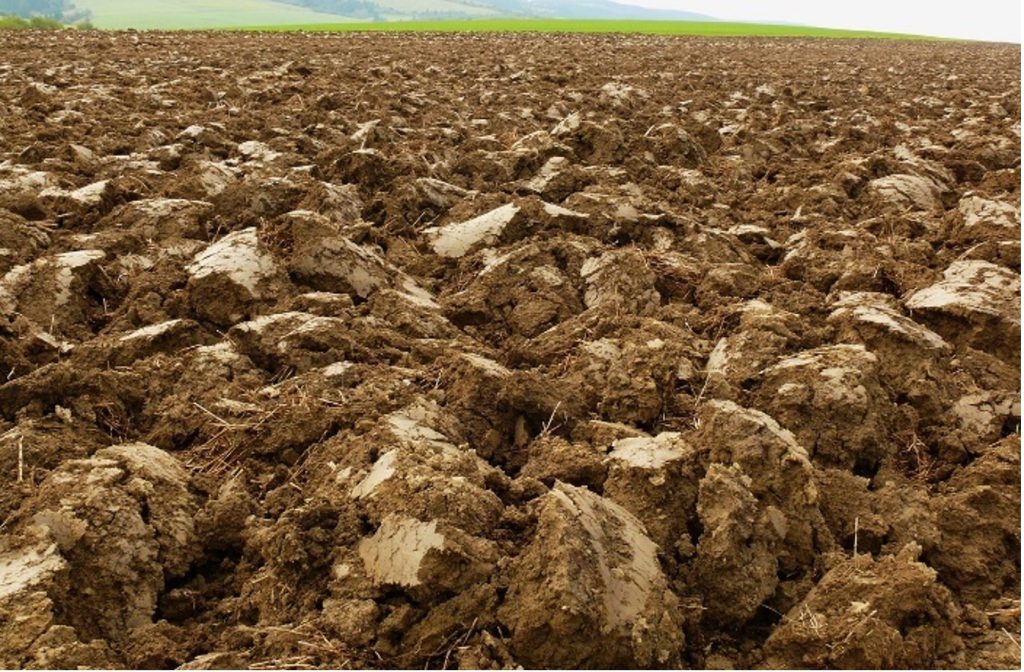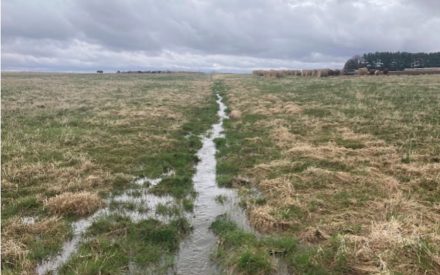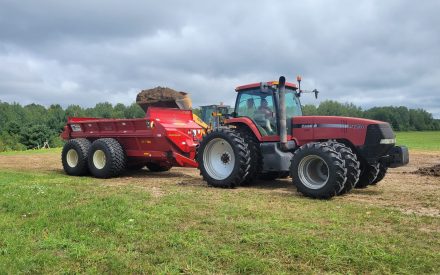Introduction to phosphorus in cropping systems
Phosphorus (P) is a key plant nutrient. Only nitrogen and potassium are required in higher amounts by crops. High soil test phosphorus fields are a looming environmental threat to surface water. Phosphorus can hitch a ride on soil particles during erosion events or dissolve in runoff water. Once moved into a lake or pond the phosphorus increases algae blooms which lower the amount of dissolved oxygen available for aquatic life when the algae die and decompose.

Can I reduce phosphorus without harming crop yield?
Phosphorus management is an ongoing and long-term process. As you read the suggested strategies below consider stacking multiple practices to reduce phosphorus loss from high soil test P fields.
Best management practices to lower phosphorus
Monitor phosphorus levels on the farm
Regular soil testing is the best tool to track and alert you to high phosphorus levels. Reevaluate individual fields with each new soil test. Has the P level gone up, down or stayed the same? On your soil report, phosphorus results will be categorized as very low (VL), low (L), optimal (O), high (H), and excessively high (EH).
If your soil test phosphorus falls into the high (H) or excessively high (EH) categories, phosphorus loss to the environment is a potential concern.
Apply phosphorus at the UW recommended rate
Follow UW nutrient guidelines (A2809) to eliminate or reduce P fertilizer if soil tests show excessively high levels. For most field and forage crops once soil test P exceeds 30 ppm there is little probability of a yield response from additional P (from fertilizer or manure).
Should I stop applying phosphorus fertilizer if my soil test is high?
Generally, yes, if a field falls into the excessively high soil test category, no P from manure or fertilizer should be applied until soil test levels are drawn down. But if a specific crop has a high P demand and shows deficiency symptoms; P applications can occur and should align with UW nutrient recommendations. Credit phosphorus contributions from manure and other organic amendments by subtracting the amount from the P recommendation.
If I stop applying phosphorus, will there be a problem?
Daniel Kaiser of University of Minnesota Extension provides insight below:
- Research has found that soil tests, on average, decrease by around 2 ppm per year without P fertilizer applied for high testing soils. The drop can be greater if soil tests are above 50 ppm, as it takes higher application rates to maintain that high of a soil test.
- Soils testing 50 ppm or higher may have enough P to supply crops for 15 to 20 years before fertilizer applications are needed.
- Read more in No P, no problem? Skipping phosphorus fertilizer application may make agronomic, economic sense.
Applying phosphorus fertilizer for both crops and the environment
The framework for applying nutrients in a way to maximize crop uptake, minimize environmental impact and optimize economic returns is using the 4R’s (Right Rate, Right Place, Right Source, Right Time).
Choose the right phosphorus fertilizer source, apply the right rate, at the right time in right place.
Phosphorus fertilizer application tips
Phosphorus does not move in the soil. Phosphorus applications should be placed below the soil surface as close to crop roots as possible without causing damage (ideally into living cover) but not with so much disturbance that soil loss becomes an issue. Placing phosphorus in-furrow with the seed, such as 2×2 below the seed at planting or subsurface banding prior to planting. This promotes better plant root uptake and avoids phosphorus buildup on the soil surface where it is more likely to runoff.
Starter phosphorus application tips
For corn grown on soils that are slow to warm in the spring, a yield response is found with a minimal amount of starter fertilizer that delivers approximately 10 lb. N, 20 lb. P2O5, and 20 lbs. of K2O. (Ch. 10 A2809 ) No more than this amount of starter should be applied to soils that are in the excessively high range. All starter fertilizer applications should be subtracted from the overall nutrient recommendation.
Manure application tips
Apply manure based on crop nitrogen needs rather than phosphorus to prevent further P buildup. Instead of using book values send manure samples to the lab for analysis before application. Apply manure to fields with low soil test P. Consider incorporating manure in a manner that does not increase soil erosion. Avoid surface applying manure on sloping or no-till ground.
Cropping systems for phosphorus management
Which crops remove the most phosphorus?
There are crops with higher P crop removal which can help draw down phosphorus over time. These crops include forage crops where you are taking multiple cuttings/harvests and other grains where you harvest the grain and straw or whole plant.
Alfalfa and Grass Hay
These perennials remove large amounts of P and reduce soil erosion.
Corn Silage
Harvesting the whole plant removes more P compared to grain corn.
Soybeans and Small Grains
Can help draw down P levels gradually.
Can cover crops help lower soil phosphorus levels?
Cover crops, like brassicas and rye, can help with high phosphorus management by double cropping. Double cropping or growing two or more crops in the same field in the same growing season. For example, growing and harvesting a winter forage or cover crop before corn or winter rye before corn silage can increase phosphorus removal. The key is harvesting the cover crop biomass and removing it from the field.
Enhancing phosphorus uptake and cycling
Phosphorus is highly reactive and quickly bonds with other nutrients, clay particles, and organic matter which influences the short and long-term plant available P. To enhance plant uptake of P, maintain an ideal soil pH for your crop rotation.
- At a soil pH of 6.5 and below, phosphorus forms compounds with iron and aluminum.
- At a pH of 7.5, phosphorus bonds with calcium.
- Ideal pH also provides the perfect environment for soil health and the microbes that decompose crop residue and cycle P to mycorrhizal fungi promoting their growth which enhances P-uptake from a larger area then crop roots can alone.
Can cover crops improve phosphorus cycling?
Depending on the goal of your cover crop uses, certain cover crops can aid in phosphorus cycling. Cereal rye and annual ryegrass scavenge excess P and roots, and biomass residue prevent runoff. The deep roots of radishes and turnips can mobilize P during the fallow season and improve soil structure.
Stack conservation and soil health practices to reduce phosphorus issues
Phosphorus binds to clay soil particles and organic matter, so reducing erosion with conservation tillage, cover crops, and buffer strips can prevent P accumulation in waterways. Conservation practices which reduce erosion, increase infiltration, and slow the movement of soil and water runoff help with soil and phosphorus loss.
The need for a multi-prong approach through stacking management strategies has shown the most promise. Learn more in Stacking conservation practices for water quality.
Reduce soil erosion to prevent P loss.
Reduce erosion and keep P in the root zone.
Trap P before it enters water bodies.
Minimize P runoff in sloped fields.
Conclusion
High soil test phosphorus is a challenging issue that requires a combination of strategies for long-term nutrient management.
Lowering phosphorus at a glance
- Monitor soil test levels for P.
- Follow UW recommendations for P fertilizer rates.
- Apply P fertilizer using the 4R’s (Rate, Place, Source, Time).
- Add and use high P removal crops to draw down P.
- Stack conservation and soil health practices.
Through using more than one of the strategies you can not only boost crop productivity by providing timely phosphorus uptake but also reduce the risk of environmental P losses to nearby water sources. Reducing phosphorus levels makes agronomic, economic, and environmental sense.
Resources
Last Updated: April 11, 2025
Reviewed by: Kelsey Hyland, Dan Smith, Landon Baumgartner, and Natasha Rayne

 ▶ Unlocking the Potential of Biological Nitrogen Fixation in Corn
▶ Unlocking the Potential of Biological Nitrogen Fixation in Corn ▶ Nitrogen Leaching: Trends, Risks and Regional Insights
▶ Nitrogen Leaching: Trends, Risks and Regional Insights ▶ What You Can and Can’t Learn from a Nitrogen Response Curve
▶ What You Can and Can’t Learn from a Nitrogen Response Curve ▶ Tools for Planning and Spreading Manure
▶ Tools for Planning and Spreading Manure


